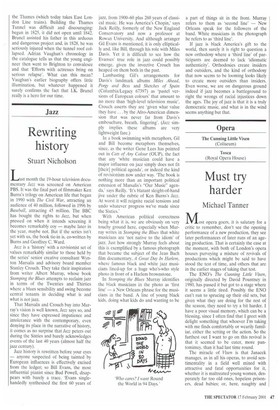Rewriting history
Stuart Nicholson
Last month the 19-hour television documentary Jazz was screened on American PBS. It was the final part of filmmaker Ken Burns's trilogy on American life that began in 1990 with The Civil War, attracting an audience of 40 million, followed in 1996 by Baseball, attracting 45 million. The BBC has bought the rights to Jazz, but when pressed on when it intends screening it becomes remarkably coy — maybe later in the year, maybe not. But if the series isn't yet with us, the book tie-in is, co-written by Burns and Geoffrey C. Ward.
Jazz is a 'history' with a revisionist set of values remarkably similar to those held by the series' senior creative consultant Wynton Marsalis and advisory board member Stanley Crouch. They take their inspiration from writer Albert Murray, whose book Stomping the Blues attempts to reclaim jazz in terms of the Twenties and Thirties where a blues sensibility and swing become central tenants in deciding what is and what is not jazz.
That Marsalis and Crouch buy into Murray's vision is well known, Jazz says so, and since they have expressed impatience and intolerance with the contemporary, even denying its place in the narrative of history, it comes as no surprise that Jazz peters out during the Sixties and barely acknowledges events of the last 40 years (almost half the jazz century).
Jazz history is rewritten before your eyes — anyone suspected of being tainted by European influences is effectively excised from the ledger; so Bill Evans, the most influential pianist since Bud Powell, disappears with barely a trace. 'Evans singlehandedly synthesised the first 60 years of jazz, from 1900-60 plus 260 years of classical music. He was America's Chopin,' says Jack Reilly, formerly of the New England Conservatory and now a professor at Rowan University. And although arranger Gil Evans is mentioned, it is only elliptically and, like Bill, through his role with Miles Davis. Yet it is difficult to see how the Evanses' true role in jazz could possibly emerge, given the invective Crouch has heaped on them both in the past.
Lambasting Gil's arrangements for Davis's landmark albums Miles Ahead, Porgy and Bess and Sketches of Spain (Columbia/Legacy 67397) as 'pastel versions of European colours' that amount to no more than 'high-level television music', Crouch asserts they are 'given what value they have. . . by the Afro-American dimension that was never far from Davis's embouchure, breath, fingering'. (Jazz simply implies these albums are very lightweight fare.) In a book swimming with metaphors, Gil and Bill become metaphors themselves, since, as the writer Gene Lees has pointed out in Cats of Any Colour (OUP), the fact that any 'white musician could have a major influence on jazz simply does not fit [their] political agenda', or indeed the kind of revisionism now under way. 'The book is nothing more than an important political extension of Marsalis's "Our Music" agenda,' says Reilly. 'It's blatant sleight-of-hand jive under the rubric of Ken Burns's Jazz. At worst it will reignite racial tensions and undo whatever progress we've made since the Sixties.'
With American political correctness being what it is, we are obviously on very touchy ground here, especially when Murray writes in Stomping the Blues that white musicians are 'not native to the idiom' of jazz. Just how strongly Murray feels about this is exemplified by a famous photograph that became the subject of the Jean Bach film documentary, A Great Day In Harlem, where famous black and white jazz musicians lined-up for a huge who's-who style photo in front of a Harlem brownstone.
In Stomping the Blues Murray identifies the black musicians in the photo as 'first line' — a New Orleans phrase for the musicians in the band. A line of young black kids, doing what kids do and wanting to be
a part of things sit in the front. Murray refers to them as 'second line' — New Orleans speak for the followers of the band. White musicians in the photograph he refers to as 'third line'.
If jazz is black America's gift to the world, then surely it is right to question a new orthodoxy where a 'third line' of participants are deemed to lack 'idiomatic authenticity'. Orthodoxies create insiders and outsiders, and the kind of orthodoxy that now seems to be looming looks likely to create more outsiders than insiders. Even worse, we are on dangerous ground indeed if jazz becomes a battleground to right the wrongs of racial injustices down the ages. The joy of jazz is that it is a truly democratic music, and what is in the wind seems anything but that.


































































 Previous page
Previous page